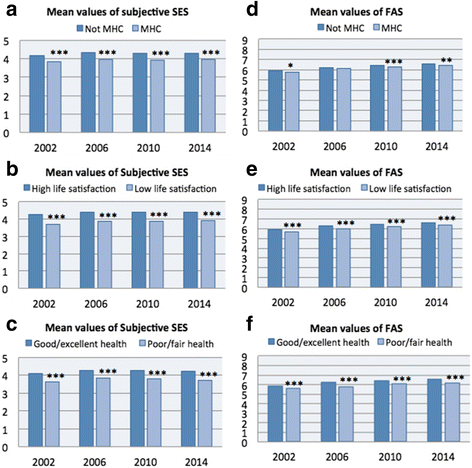Socioeconomic inequalities in health among Swedish adolescents - adding the subjective perspective
- PMID: 29061173
- PMCID: PMC5653986
- DOI: 10.1186/s12889-017-4863-x
Socioeconomic inequalities in health among Swedish adolescents - adding the subjective perspective
Abstract
Background: Socioeconomic inequalities in adolescent health predict future inequalities in adult health. Subjective measures of socioeconomic status (SES) may contribute with an increased understanding of these inequalities. The aim of this study was to investigate socioeconomic health inequalities using both a subjective and an objective measure of SES among Swedish adolescents.
Method: Cross-sectional HBSC-data from 2002 to 2014 was used with a total sample of 23,088 adolescents aged 11-15 years. Three measures of self-rated health (dependent variables) were assessed: multiple health complaints, life satisfaction and health perception. SES was measured objectively by the Family Affluence Scale (FAS) and subjectively by "perceived family wealth" (independent variables). The trend for health inequalities was investigated descriptively with independent t-tests and the relationship between independent and dependent variables was investigated with multiple logistic regression analysis. Gender, age and survey year was considered as possible confounders.
Results: Subjective SES was more strongly related to health outcomes than the objective measure (FAS). Also, the relation between FAS and health was weakened and even reversed (for multiple health complaints) when subjective SES was tested simultaneously in regression models (FAS OR: 1.03, CI: 1.00;1.06 and subjective SES OR: 0.66, CI: 0.63;0.68).
Conclusions: The level of socioeconomic inequalities in adolescent health varied depending on which measure that was used to define SES. When focusing on adolescents, the subjective appraisals of SES is important to consider because they seem to provide a stronger tool for identifying inequalities in health for this group. This finding is important for policy makers to consider given the persistence of health inequalities in Sweden and other high-income countries.
Keywords: Adolescence; HBSC; Self-rated health; Socioeconomic inequality; Socioeconomic status.
Conflict of interest statement
Authors’ information
School of Health and Welfare at Halmstad University, SE 301 18 Halmstad, Sweden.
Ethics approval and consent to participate
The HBSC-survey is carried out every fourth year and follows the ethical principles of the WMA Helsinki declarations in protecting integrity, privacy and confidentiality of participants. The national Data Inspection Board monitors the standards of privacy. The Swedish HBSC-survey also fulfils the rules and guidelines from the Swedish Research Council regarding information, consent, confidentiality and usage of data. Participation in the HBSC-survey is voluntary and all participants are informed about the objectives of the survey.
Consent for publication
Not applicable.
Competing interests
The authors declare that they have no competing interests.
Publisher’s Note
Springer Nature remains neutral with regard to jurisdictional claims in published maps and institutional affiliations.
Figures
References
-
- Elgar FJ, Pförtner T-K, Moor I, de Clerq B, Stevens GWJM, Currie C. Socioeconomic inequalities in adolescent health 2002–2010: a time-series analysis of 34 countries participating in the health behaviour in school-aged children study. Lancet. 2015;385:2088–2095. doi: 10.1016/S0140-6736(14)61460-4. - DOI - PubMed
-
- Currie C, Zanotti C, Morgan A, et al. Social determinants of health and well-being among young people. Health behaviour in school-aged children (HBSC) study: international report from the 2009/2010 survey. Copenhagen: WHO Regional Office for Europe (Health Policy for Children and Adolescents; 2012. p. 6.
-
- Levin KA, Torsheim T, Vollebergh W, Richter M, Davies CA, Schnohr CW, Due P, Currie C. National income and income inequality, family affluence and life satisfaction among 13 year old boys and girls: a multilevel study in 35 countries. Soc Indic Res. 2010;104(2):179–194. doi: 10.1007/s11205-010-9747-8. - DOI - PMC - PubMed
-
- Rathmann K, Ottova V, Hurrelmann K, de Looze M, Levin K, Molcho M, Richter M. Macro-level determinants of young people's subjective health and health inequalities: a multilevel analysis in 27 welfare states. Maturitas. 2015;80(4):414–20. - PubMed
MeSH terms
LinkOut - more resources
Full Text Sources
Other Literature Sources
Medical
Research Materials
Miscellaneous


